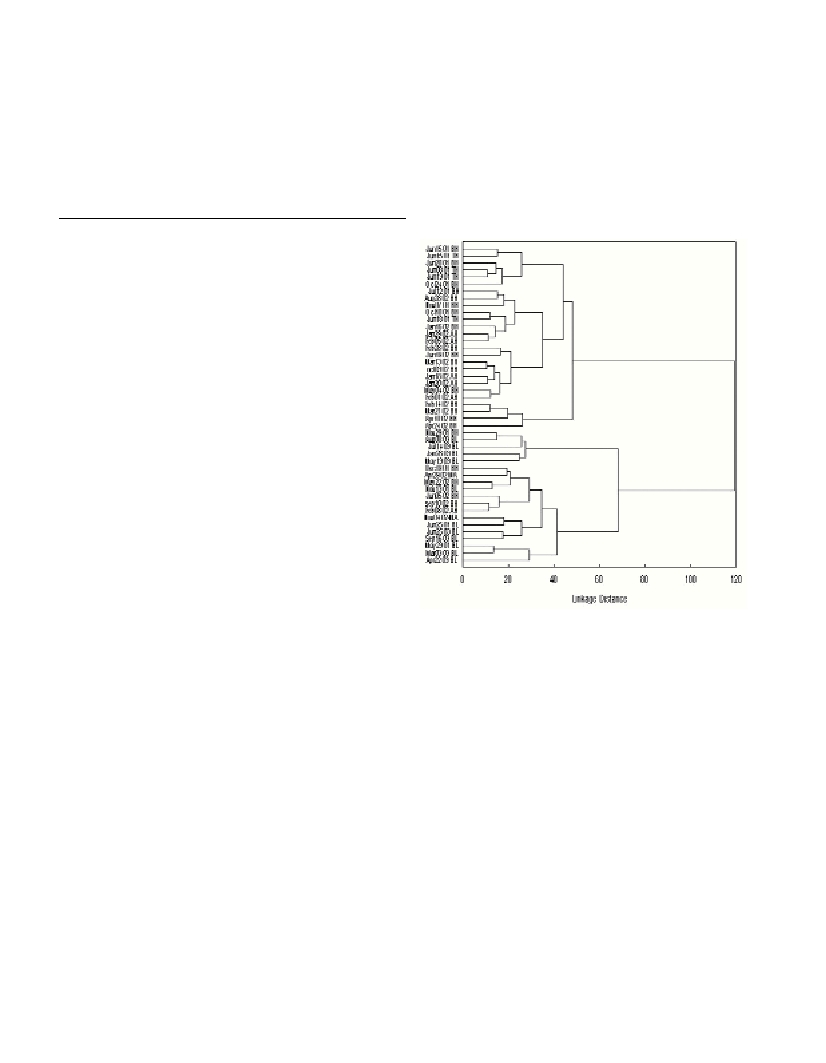Rapp. Comm. int. Mer Médit., 37,2004
287
FUNCTIONAL DIVERSITY OF BACTERIOPLANKTON COMMUNITIES IN
CONTRASTING ENVIRONMENTS OF THE NW MEDITERRANEAN COAST
Sala M.M.*, Felipe J., Gasol J.M., Pinhassi J. and Estrada M.
Institut de Cičncies del Mar-CMIMA (CSIC), Barcelona, Spain - * msala@icm.csic.es
Abstract
We studied the metabolic diversity of bacterioplankton in four contrasting environments of the Catalan coast (NW Mediterranean) by
comparing the profiles of sole carbon sources using Biolog-Eco microplates. Bacterioplankton communities were metabolically different
in enclosed and open environments. Patterns of carbon utilization during harmful algal blooms were not different from those obtained from
other enclosed environments.
Keywords: bacterioplankton metabolism, Biolog, HABs, coastal zone
Introduction
A lot of information is now available on the phylogenetic bacterial
diversity in marine environments. However, to understand the
biogeochemical role of different microbial communities it is essential
to have knowledge also on their functional diversity. Previous studies
in the coastal zone of the Catalan coast have shown that the bacterial
community was phylogenetically different in enclosed from open
areas (1). To our knowledge, no information on functional diversity in
the Mediterranean Sea has been reported. In other environments,
functional diversity has been assessed using Biolog plates (2). Since
each species of bacteria differ in the specific organic substrates that
they can use as carbon and energy sources, each community would
have a characteristic profile of carbon source utilization in the Biolog
plate. The aim of our study was to evaluate if bacterial functional
diversity was different in zones with different trophic conditions.
Among the enclosed zones, we have included two blooms of the toxic
dino?agellate Alexandrium.
Material and methods
Metabolic diversity of bacterioplankton was studied in the surface
of four different regions of the Catalan Coast (NW Mediterranean).
Station AH (Arenys de Mar Harbour) was sampled in January 2002
during a bloom of the dino?agellate Alexandrium minutum. Station
TH (Tarragona Harbour) was sampled in June 2001 during a bloom of
the dino?agellate Alexandrium catenella). Station BH (Barcelona
Harbour) was sampled regularly from June 2001 until October 2002 a
period with no HABs (harmful algal bloom) detectable. Apart from
the three harbours, we collected samples from two coastal open
environments in Blanes (St. BL) and Masnou (St. MA) in different
periods between 2001 and 2003.
Metabolic diversity was assessed by means of Biolog-Eco
microplates that provide profiles of sole carbon source utilization (see
ref. 3 for a review). Biolog-Eco plates contain 31 different carbon
sources in triplicates. After inoculation of the wells (150
µ
l sample),
the plates are incubated for 6 days and absorbance is afterwards
measured at 590 nm. The pattern of color development of each plate
gives a fingerprint for every community. The patterns of color
development were compared after normalizing the data according to
ref. 4. Hierarchical cluster analysis (HCA) was used to determine
differences between patterns of substrate utilization. The Wards
Method and City-block distance clustering was used in this analysis.
Data from HCA were used to construct a dendogram (Fig.1) and the
shorter the leaf the greater the similarity.
Results and discussion
The dendogram, and the principal component analysis, showed two
groups of samples. The first group contained all the samples from the
oligotrophic areas (BL and MA) and some BH samples with low
chlorophyll concentrations. The second group contained only samples
from the enclosed environments, i.e. the harbours. Included in this
group we found the samples from HABs (AH and TH) and most of the
BH samples. Seasonal grouping could not be easily observed among
the enclosed samples from BH. Patterns of metabolic activity of
bacterioplankton during HABs did not differ from those obtained in
BH along the year, when no dino?agellates bloom was detected.
Our results suggest that, similarly to phylogenetic diversity (1),
functional diversity of bacterioplankton populations is different in
harbors than in open coastal stations, with metabolic capabilities of
bacterioplankton during HABs not different from those of other
enclosed areas.
Fig.1. HCA results for Biolog data obtained from the Catalan coast.
Branches are labeled by date and station: BH: Barcelona harbour, TH:
Tarragona harbour, AH: Arenys harbour, BL: Blanes and MA: Masnou.
Acknowledgements
The study was supported by the EU projects: BIOHAB (EVK3-
CT1999-00015) and BASICS (EVK3-CT2002-00078).
References
1-Schauer, M., Massana, R., and Pedrós-Alio, C., 2000. Spatial
differences in bacterioplankton composition along the Catalan coast (NW
Mediterranean) assessed by molecular fingerprinting. FEMS Microb.
Ecol., 33: 51-59.
2-Schultz, G.E,. and Ducklow, H., 2000. Changes in bacterioplankton
metabolic capabilities along a salinity gradient in the York River estuary,
Virginia, USA. Aquat. Microb. Ecol.,22: 163-174.
3-Preston-Mafham, J., Boddy, L., and Randerson, P.F., 2002. Analysis of
microbial community functional diversity using sole-carbon-source
utilisation profiles - a critique. FEMS Microb. Ecol., 42: 1-14.
4-Garland, J.L., and Mills, A.L. 1991. Classification and characterization
of heterotrophic microbial communities on the basis of patterns of
community-level sole-carbon-source utilization. Appl. Environ. Microbiol.
57: 2351-2359.

